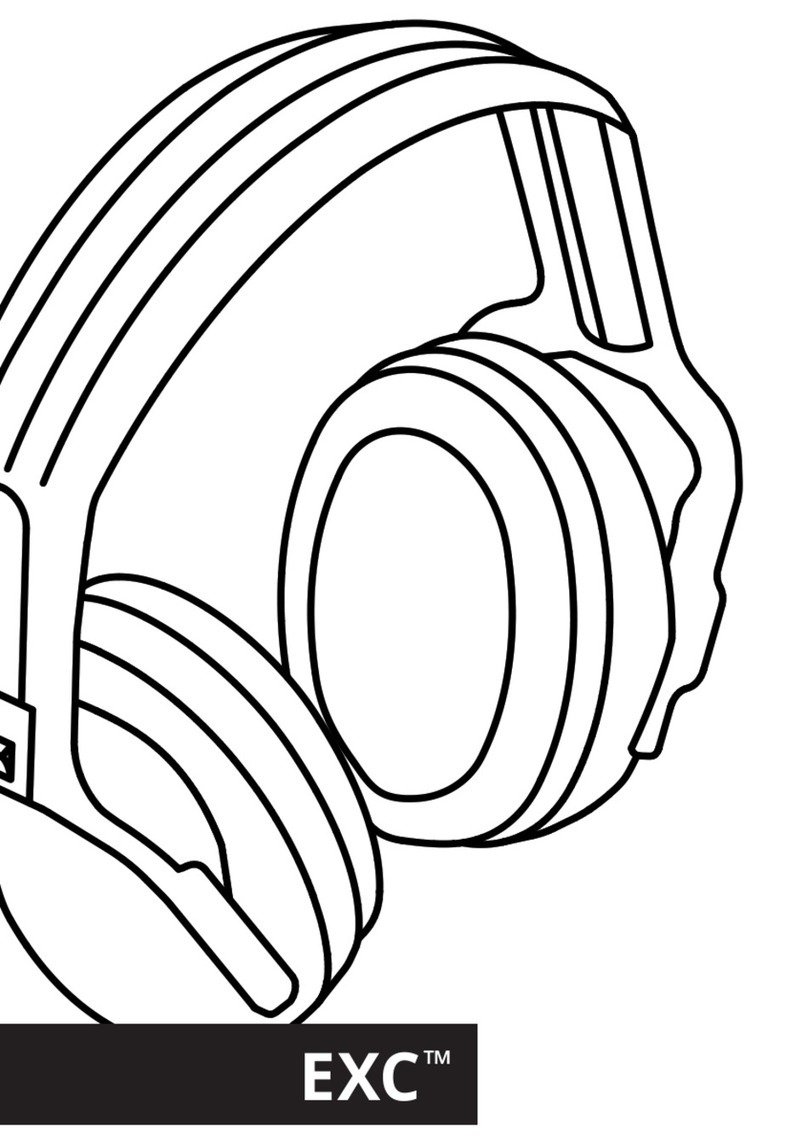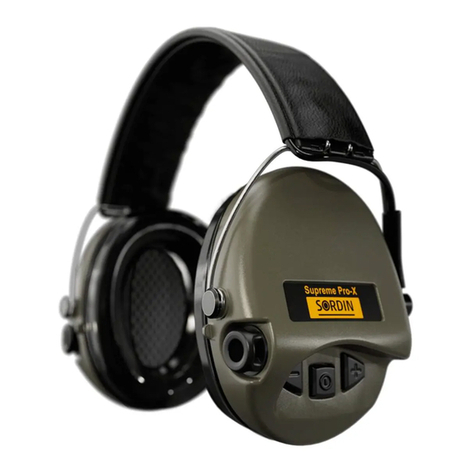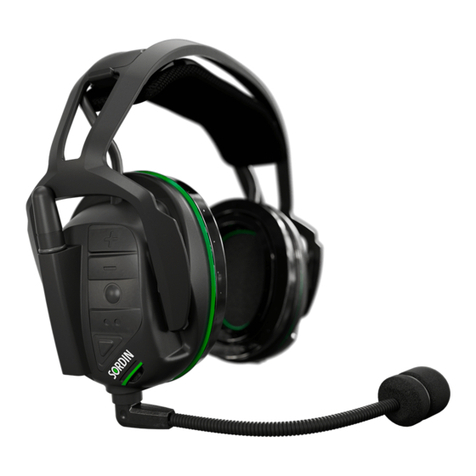Sordin Supreme Pro Operation manual

SORDIN SUPREME PRO - PRODUCT FEATURES
Durable headband, for high requirements
on sound reproduction and comfort.
Sordin Supreme is a hearing protector equipped with electronics for
listening to ambient sound. The sound is reproduced by speakers inside
the hearing protector. The sound reproduction is limited to a maximum of
82 dB(A) to prevent damage to hearing. Sordin Supreme is included in a
series of products developed to improve your working environment or
leisure time, whenever exposed to noise. To be really satisfied with the
product it is important that you read through all the user’s instructions,
and save for future reference.
IMPORTANT INFORMATION ABOUT LEVEL DEPENDENT/
RETURN GUARANTEE (fig. A)
This hearing protector is equipped with level-dependent function. The
electronics consists of two externally mounted microphones that pick up
the ambient sound (A1). The level dependent sound is reproduced inside
the hearing protector at a safe level (max. 82 dB(A)). The sound is
reproduced in stereo to maintain or improve the sense of direction. The
function is designed for use in environments where it is desirable that
ambient sounds can be heard, e.g., warning signals, conversation, traffic,
etc.
If this product does not meet your expectations, please return it without
delay to the point of sale and your money will be refunded. NOTE. This
possibility will become void if the product has been in regular use.
USER’S INSTRUCTIONS
ACTIVATING THE HEARING PROTECTOR /
BATTERY INSTALLATION / REPLACEMENT (fig. B)
The product is equipped with two standard 1.5 V AAA/LR03 batteries.
Rechargeable batteries, for example NiMH 1.2 V or NiCd 1.2 V, should
not be used as they may significantly reduce the operation life of the
product. The batteries, which are completely enclosed to protect against
moisture and dirt, are housed in the unique battery compartment located
in the cup, which does not feature the keyboard. When installing or
replacing batteries follow the instructions below (fig. B):
•Hold the cup upside down. Unscrew the battery cover (fig. B1).
•Insert the first battery with the (-) pole facing inwards (fig. B2).
•Shake the cup lightly so that the battery falls into place and may
not be visible (fig. B3).
•Insert the second battery with the (+) pole facing inwards (fig. B4).
•Refit the battery cover (fig. B5).
Note! Ensure the battery poles (+ /-) are correctly aligned.
FUNCTION KEYS (figure C)
On and off, ( )
Press key ( ) to activate the electronic functions. To switch off, hold the
same key ( ) pressed in for 2 seconds.
Volume adjustment,
Volume of the level dependent function is adjusted by short presses on
the volume keys, down (-) or up (+). The volume starts in the mode at
which it was switched off. The volume can be adjusted in five steps. The
output signal from the sound reproduction system of the product will not
exceed known risk levels for damage to hearing. Sound via the speakers
is limited to maximum 82 dB(A) equivalent sound level.
Battery-saving mode
This product is provided with a battery economy function to ensure
maximum life of the batteries. The function automatically switches off the
level dependent mode after 4 hours if no key is activated during this
period. To restart, push the key located at the middle of the keypad ( ).
Amplification
At the two highest volume stages Sordin Supreme Pro amplifies the
ambient sound by up to 12 dB.
Battery-saving function – warning before switching off
About 2 minutes before automatic switch-off a tone will be heard as a
warning that sound will be switched off. Press any key to delay the
switch-off by a further 4 hours.
Battery warning
A tone will be heard when about 40 hours battery life remains. The
battery warning will be heard after 10 seconds in connection with starting
up the electronics.
FITTING INSTRUCTIONS (fig. D)
The Supreme is designed to be worn in over-the-head mode and
adjusted for size by pulling the headband (fig. D1). Brush excess hair out
from beneath the cushions with your hand. Place the cups over your ears
and adjust the headband and cups to a comfortable position (fig. D2). Be
certain that the cushions seal tightly around the ears with no interference
from objects such as respirator headband or arms of glasses in order to
obtain the best performance. Make sure the headband is not stored in a
stretched position and that the cushions are not pressed together when
the earmuffs are not in use.
UNFOLDING AND FOLDING THE EAR MUFFS (fig. E)
To unfold, pull the headband up to its maximum position whilst holding
the cups (fig. E1). To fold, press on top of the headband until the
headband touches the top of the cups (fig E2).
MAINTENANCE
The outside of the muff and the sealing ring can easily be cleaned with
soap and water. Ear muffs and in particular cushions may deteriorate
with use and ageing and should be inspected regularly for cracks and
leakage. The cushions are filled with foam and are replaceable. Worn or
damaged parts are easily replaced (figure F). Use only hygiene kits from
the manufacturer, designed for electronics, order number 60089. The
hygiene kit should be replaced at least twice a year for standard use to
ensure that the noise attenuation performances are maintained. Certain
chemical substances may adversely affect this product. Further
information should be sought from the manufacturer.
The user must ensure that the hearing protectors or hearing protector:
- fit properly and are adjusted and maintained in compliance with our
instructions
- is used all the time in noisy environments
- is inspected regularly to ensure good condition.
If the above recommendations are not adhered to, the protection
afforded by the earmuffs can be severely impaired. Moisture may occur
inside the cups if used for long periods. To avoid long-term affects of
moisture on the electronic components it is recommended that the
acoustic absorbent be regularly removed to allow the muffs to dry, e.g.,
overnight (figure F) When removing the sealing ring and absorbent take
great care not to touch the electronics board or cables. Changes in
position of cables could cause disturbance in the system. Do not subject
the hearing protector to rough handling, which can damage the
electronics.
The earmuffs must not be immersed in water!
STORAGE
When the hearing protector is not in use, the headband should not be
extended or the sealing rings compressed. Keep the muffs dry and clean
and keep them in normal room temperature. Do not allow the hearing
protector to lie in direct sunlight. If the product is to be stored for a longer
period it is recommended that the batteries be removed from the battery
holder to prevent damage. Store the product in an unfolded position in
order to avoid damage to the cushions.
If the above recommendations for the hearing protectors are not
adhered to the attenuation values ability could deteriorate
considerably.
LIMITED TROUBLE SHOOTING
If the electronics cease to function please check the following:
•Replace the batteries with new ones.
•Ensure that the batteries are correctly fitted in the hearing
protector.
•Ensure that the battery plates make good contact with the
batteries.
•Ensure that the battery plates have not become coated with
verdigris.
Iif this does not help, consult the point of sale.

A1
A
WARNING!
•This product is provided with electronic reproduction of ambient sound. The user
must check the function before use. If distortion or any other fault is detected, follow
the instructions for changing and maintenance of the batteries. If this does not help,
consult an authorized agent.
•The function may deteriorate with battery usage. In normal use, the estimated life of
the batteries is about 600 hours
•The estimated A-weighed sound level inside the muff, with consideration taken to
attenuation values (table, figure K), shall not exceed 82 dB(A).
•Remember that hearing protectors generally can shut out ambient sound, such as
warning shouts, alarms and other important signals. Be therefore extra cautious of
your surroundings when wearing hearing protectors.
•The integrated microphones for reproduction of ambient sound increase safety
considerably in your daily work. NOTE. It is possible to disconnect the level
dependent function, which means that warning signals and warning shouts would be
much more difficult to hear. To minimize the risk of accidents we therefore
recommend that the level dependent function be connected as far as possible.
•The output signal from the level dependent function can exceed the actual external
sound level.
•••••The level dependent function may deteriorate in rain or moist conditions and the user
should therefore be aware of the possible deterioration. If deterioration occurs,
immediately allow the microphones in the hearing protector to dry (with open muffs
for 24 h) until the function is fully restored.
•The product and the batteries are to be disposed of in conformance with national
regulations.
Tested according to ANSI Specifications, ANSI S3.19-1974
Information required by E.P.A:
The level of noise entering a person’s ear, when hearing protection is
worn as directed, is closely approximated by the difference between the
A-weighted environmental level and the NNR.
Example: The environmental noise level at the ear is 92 dB(A). The NNR
is 23 decibels (dB). The level of noise entering the ear is approximately
equal to 69 dB(A).
CAUTION:
For noise environments dominated by frequencies below 500 Hz, the C-
weighted environmental noise level should be used. Improper fit of this
device will reduce its effectiveness in attenuating noise. Although hearing
protections can be recommended for protection against harmful effect of
impulse noise, the Noise reduction Rating (NRR) is based on the
attenuation of continuous noise and may not be an accurate indicator of
the protection attainable against impulsive noise, such as gunfire.
ATTENUATION DATA – Sordin Supreme Pro
Frequency (Hz) 125 250 500 1000 2000 3150 4000 6300 8000 NRR
Mean (dB) 11,1 16,5 23,1 25,0 29,5 33,9 35,5 38,3 38,7
Standard
deviation (dB) 2,6 3,0 3,2 2,8 4,1 3,1 3,6 4,0 3,2
18
B
B1B2
B3 B4 B5
D
D1
D2
E E1 E2 F
C
A1
A
WARNING!
•This product is provided with electronic reproduction of ambient sound. The user
must check the function before use. If distortion or any other fault is detected, follow
the instructions for changing and maintenance of the batteries. If this does not help,
consult an authorized agent.
•The function may deteriorate with battery usage. In normal use, the estimated life of
the batteries is about 600 hours
•The estimated A-weighed sound level inside the muff, with consideration taken to
attenuation values (table, figure K), shall not exceed 82 dB(A).
•Remember that hearing protectors generally can shut out ambient sound, such as
warning shouts, alarms and other important signals. Be therefore extra cautious of
your surroundings when wearing hearing protectors.
•The integrated microphones for reproduction of ambient sound increase safety
considerably in your daily work. NOTE. It is possible to disconnect the level
dependent function, which means that warning signals and warning shouts would be
much more difficult to hear. To minimize the risk of accidents we therefore
recommend that the level dependent function be connected as far as possible.
•The output signal from the level dependent function can exceed the actual external
sound level.
•••••The level dependent function may deteriorate in rain or moist conditions and the user
should therefore be aware of the possible deterioration. If deterioration occurs,
immediately allow the microphones in the hearing protector to dry (with open muffs
for 24 h) until the function is fully restored.
•The product and the batteries are to be disposed of in conformance with national
regulations.
Tested according to ANSI Specifications, ANSI S3.19-1974
Information required by E.P.A:
The level of noise entering a person’s ear, when hearing protection is
worn as directed, is closely approximated by the difference between the
A-weighted environmental level and the NNR.
Example: The environmental noise level at the ear is 92 dB(A). The NNR
is 23 decibels (dB). The level of noise entering the ear is approximately
equal to 69 dB(A).
CAUTION:
For noise environments dominated by frequencies below 500 Hz, the C-
weighted environmental noise level should be used. Improper fit of this
device will reduce its effectiveness in attenuating noise. Although hearing
protections can be recommended for protection against harmful effect of
impulse noise, the Noise reduction Rating (NRR) is based on the
attenuation of continuous noise and may not be an accurate indicator of
the protection attainable against impulsive noise, such as gunfire.
ATTENUATION DATA – Sordin Supreme Pro
Frequency (Hz) 125 250 500 1000 2000 3150 4000 6300 8000 NRR
Mean (dB) 11,1 16,5 23,1 25,0 29,5 33,9 35,5 38,3 38,7
Standard
deviation (dB) 2,6 3,0 3,2 2,8 4,1 3,1 3,6 4,0 3,2
18
B
B1B2
B3 B4 B5
D
D1
D2
E E1 E2 F
C
SORDIN AB - SWEDEN #75302
www.sordin.com
PM274-01
Other manuals for Supreme Pro
1
Other Sordin Protection Device manuals
Popular Protection Device manuals by other brands

nxt
nxt BIA-nXt-DPC 1-22 Installation and operation manual

TFortis
TFortis SG-Switch operating manual

BERNINI DESIGN
BERNINI DESIGN Be172 instruction manual

Rayleigh Instruments
Rayleigh Instruments RI-ENERGYSET-3P-ESS-50-100 manual

E.K.T.
E.K.T. ke-DP01 quick start guide

Sola HD
Sola HD STV100K Series instruction manual














